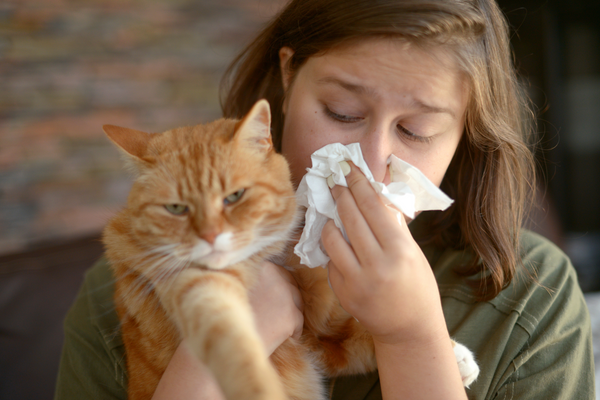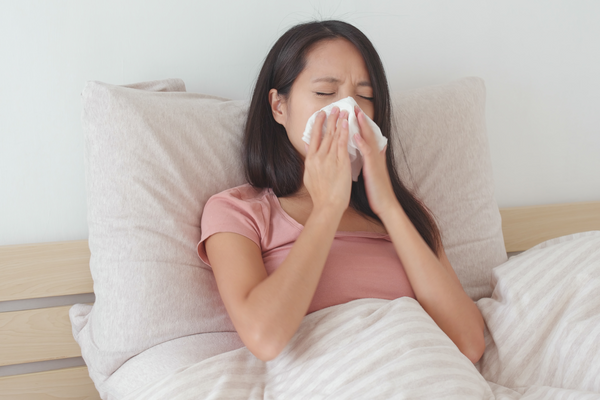What is Allergy-Induced Asthma?

People with asthma are familiar with the shortness of breath and wheezing that accompany an asthma flare-up. But did you know that common allergens, such as dust mites and pet dander, may be contributing to your asthma symptoms? Allergy-induced asthma, or allergic asthma, is the most common form of asthma and occurs when allergens trigger an asthma response in the body that causes the airways to swell.
Asthma and allergies often go hand-in-hand. In the U.S., about 25 million people have asthma. Out of that group, about 60% have asthma that is caused by allergies. Knowing if your asthma is allergy-induced is essential for taking control of your condition. Read on to learn about what causes allergy-induced asthma, common treatments, and how to reduce or avoid symptoms.
Symptoms of Allergy-Induced Asthma
Many of the symptoms of allergic and non-allergic asthma are the same, but the triggers may be different. Symptoms of allergy-induced asthma can vary from person-to-person, but generally include:
- Coughing
- Difficulty breathing or shortness of breath
- Wheezing
- Chest tightness
- Rapid breathing
Some people may also experience typical allergy symptoms, such as sneezing, itchy eyes, runny nose, and rash or hives.
Common Triggers of Allergy-Induced Asthma
Asthma is often triggered by environmental allergens. If you are allergic to a substance, or allergen, exposure to it triggers a response starting in the immune system. Through a complex reaction, these allergens then cause the passages in the airways of the lungs to become swollen and inflamed, which results in wheezing, coughing, and other asthma symptoms. Identifying, controlling, and avoiding your triggers is crucial for managing your allergic asthma.
Some of the most common triggers include:
Dust mites
While these microscopic insects are much too small to be seen by the naked eye, they are still the most common indoor allergen. Dust mites mainly feed on the tiny skin flakes that people and animals shed each day. These flakes work their way deep down into the inner layers of upholstered furniture, mattresses, carpets, bedding, pillows, clothing, and even stuffed toys. These are the places where mites thrive. Both the body parts and feces of dust mites are considered allergens.
Pet dander
The Asthma and Allergy Foundation of America (AAFA) reports that allergies to pets are prevalent, affecting millions of Americans. An estimated 15 to 30% of people with allergies have a reaction to cats or dogs, with cat allergies being twice as common as dog allergies. In the case of pets, the allergy has nothing to do with fur, as many people believe. Instead, it comes down to animal dander, an otherwise harmless protein found in a pet’s skin, saliva, and urine, according to the Mayo Clinic. The allergens can then be deposited on the animal’s fur through licking. Once the fur dries, the particles can flake off and become airborne––making it very easy to spread the allergens. In fact, animal allergens are often detected in places where no animals live; people who have pets or have been around animals may have carried the allergens into the space.
Mold
Mold can grow on almost any surface when moisture is present. Outdoors, mold lives in soil, on leaves, wood, and other plant debris. Indoors, mold can be found in a wet bathroom, a damp basement or laundry room, around window frames, under the kitchen sink, and more. Mold and mildew will develop within 24 to 48 hours of water exposure and will continue to grow until the source of moisture is eliminated, and the spores are destroyed.
Related: The Top 5 Myths About Mold Removal, Debunked
Cockroaches
The body parts, saliva, and droppings of cockroaches are all considered allergens. Yikes! These pesky insects live all over the world and in most climates; studies show that most urban homes have cockroaches. Even tiny particles of dead cockroaches settle in dust and end up in the air we breathe; this can trigger an asthma attack. Cockroaches are attracted to food, water, and shelters such as clutter and cardboard.
Pollen
Pollen from trees, grasses, weeds, and other plants is a common allergen. These airborne particles often peak during different seasons of the year but can linger inside of your home (and air ducts) all year long.
Food allergies can also cause asthma flares. It’s also important to note that some people with asthma do not have allergies. Asthma symptoms may also be triggered by viral or bacterial infections, exercise, cold air, or related conditions. If you’re not sure about what is triggering your symptoms, be sure to consult your doctor, allergist, or immunologist to diagnose your condition and find the best course of treatment.
Related: Common Asthma Triggers & How to Reduce Them in Your Home
How Can Allergy-Induced Asthma Be Managed?
The main goal of treating allergy-induced asthma is to control the condition. Your doctor will work with you to develop ways to manage your allergic asthma. These may include:
Developing an Asthma Action Plan
If you have asthma, it’s crucial to have a plan in place that helps you know what to do when you have a flare-up or experience symptoms. Your plan may include things like which medications to take, how to recognize when your symptoms worsen, and what to do in an emergency. If you don’t already have an Asthma Action Plan in place, check out this plan from the Asthma and Allergy Foundation of America (AAFA).
Finding the Best Medication For You
In many cases, allergy medications (for example, antihistamines) can effectively prevent and reduce allergy symptoms – and allergy-induced asthma symptoms as a result. While allergy medications help treat the symptoms of allergies, they don’t address the root cause.
Learning to Identify and Avoid Triggers
While asthma itself can’t be prevented or cured, you can reduce your risk of an allergy-induced asthma attack by knowing your triggers and controlling your environment. Our products strike at the root causes of many common allergic reactions.
Here are some actions you can take to reduce or eliminate common environmental allergens inside of your home:
- Have pets? Regularly use The Ecology Works Anti-Allergen Pet Shampoo to bathe your furry companions. Our shampoo neutralizes allergens (including pet dander and dust mite allergens) and helps pets – as well as owners – with allergies.
- Dust often around the home using a damp microfiber cloth. For extra dust-busting (and allergen-busting!) power, spray the cloth with The Ecology Works Anti-Allergen Solution.
- After thoroughly vacuuming (preferably with a HEPA filter vacuum to avoid the captured dirt, dust, and allergens going airborne), use The Ecology Works Anti-Allergen Solution on upholstered furniture, bedding, carpets, pillows, pet beds, and other soft surfaces to neutralize allergens on contact.
- At least twice yearly (or more often if you have moderate to severe allergies), use a rinse-and-vac cleaner on upholstery, carpet, rugs, and mattresses to deep clean and remove dust mites. Also, adding a miticide, like The Ecology Works Dust Mite & Flea Control, will help to keep dust mites from coming back. Remember that dust mites also thrive in places with high humidity, so make sure you allow plenty of time for thorough drying; a fan will help speed up your drying time.
- If mold is a problem in your home, first clean up the visible mold (seek expert help if needed) and eliminate the excess moisture, making sure to address any leaks. Use Vital Oxide to get to the root of the problem and to help keep mold and mildew from coming back. Vital Oxide is a proven mold and mildew killer with up to seven months of residual effects. It’s also safe to use on surfaces traditional mold and mildew killers would damage, such as carpeting and marble. P.S., Vital Oxide is highly effective in removing and reducing cockroach matter and allergens.
- At least once weekly, wash bedding, washable throw rugs, and blankets with The Ecology Works Anti-Allergen Laundry Detergent to eliminate allergens.
Have questions about controlling common indoor allergens? We have answers! The Ecology Works has been helping people with allergies and asthma since 1993. We can help you select the products you need to live a better, allergen-free life. Please feel free to Contact Us or message us on Facebook. No question is too small! We’re here to help.





